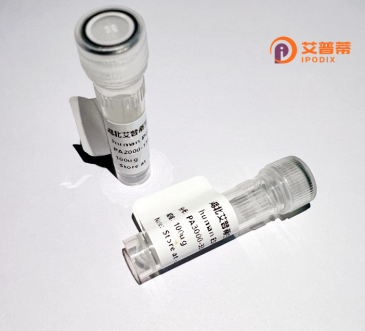
| 纯度 | >90%SDS-PAGE. |
| 种属 | Human |
| 靶点 | TRIO |
| Uniprot No | O75962 |
| 内毒素 | < 0.01EU/μg |
| 表达宿主 | E.coli |
| 表达区间 | 1-372 aa |
| 活性数据 | MTPDLLNFKKGWMSILDEPGEPPSPSLTTTSTSQWKKHWFVLTDSSLKYYRDSTAEEADELDGEIDLRSCTDVTEYAVQRNYGFQIHTKDAVYTLSAMTSGIRRNWIEALRKTVRPTSAPDVTKLSDSNKENALHSYSTQKGPLKAGEQRAGSEVISRGGPRKADGQRQALDYVELSPLTQASPQRARTPARTPDRLAKQEELERDLAQRSEERRKWFEATDSRTPEVPAGEGPRRGLGAPLTEDQQNRLSEEIEKKWQELEKLPLRENKRVPLTALLNQSRGERRGPPSDGHEALEKEVQALRAQLEAWRLQGEAPQSALRSQEDGHIPPGYISQLVGVITVPVLQTRPLSSERLCDLPKVTPPAGLKGGI |
| 分子量 | 67.32 kDa |
| 蛋白标签 | GST-tag at N-terminal |
| 缓冲液 | PBS, pH7.4, containing 0.01% SKL, 1mM DTT, 5% Trehalose and Proclin300. |
| 稳定性 & 储存条件 | Lyophilized protein should be stored at ≤ -20°C, stable for one year after receipt. Reconstituted protein solution can be stored at 2-8°C for 2-7 days. Aliquots of reconstituted samples are stable at ≤ -20°C for 3 months. |
| 复溶 | Always centrifuge tubes before opening.Do not mix by vortex or pipetting. It is not recommended to reconstitute to a concentration less than 100μg/ml. Dissolve the lyophilized protein in distilled water. Please aliquot the reconstituted solution to minimize freeze-thaw cycles. |
以下是关于重组人TRIO蛋白的3篇代表性文献概览:
---
1. **文献名称**:*TRIO binds ATP and regulates its activity through a non-canonical nucleotide-binding domain*
**作者**:Bouquier N, et al.
**摘要**:该研究发现TRIO蛋白的RhoGEF结构域存在非典型的核苷酸结合域,能够结合ATP并调控其GEF酶活性,揭示了ATP在TRIO介导的细胞骨架动态调控中的新机制。
---
2. **文献名称**:*Germline mutations in TRIO are associated with neurodevelopmental disorders*
**作者**:Pengelly RJ, et al.
**摘要**:通过基因测序发现,TRIO蛋白的编码基因在神经发育障碍患者中存在胚系突变,表明TRIO的RhoGEF功能异常可能导致突触形成和神经元迁移缺陷,提示其与自闭症谱系障碍的关联。
---
3. **文献名称**:*TRIO-RAC1 axis promotes tumor cell invasion and metastasis in gastric cancer*
**作者**:Zhu Y, et al.
**摘要**:研究证实TRIO通过激活RAC1信号通路增强胃癌细胞的侵袭和转移能力,临床数据分析显示TRIO高表达与患者预后不良相关,为靶向TRIO的癌症治疗提供了理论依据。
---
如需具体文献链接或补充更多研究,可进一步说明!
TRIO (Triple functional domain protein) is a large, evolutionarily conserved protein that acts as a guanine nucleotide exchange factor (GEF) for Rho GTPases, primarily regulating RhoA and Rac1 signaling pathways. It plays critical roles in cytoskeleton remodeling, cell migration, and neuronal development, including axon guidance and synapse formation. Structurally, TRIO contains two distinct GEF domains (GEF1 for Rac1 and GEF2 for RhoA) and a kinase domain, enabling its dual regulatory function in GTPase activation and downstream signaling.
Dysregulation of TRIO is linked to neurodevelopmental disorders, cancers, and cardiovascular diseases. For instance, mutations in TRIO are associated with intellectual disability and autism spectrum disorders, while its overexpression in cancers promotes invasive cell behavior.
Recombinant human TRIO protein, produced using bacterial or mammalian expression systems, facilitates mechanistic studies of its GEF/kinase activities and interactions. Tagged versions (e.g., His, GST) allow purification and applications in biochemical assays, drug screening, or structural studies. Researchers use recombinant TRIO to dissect its role in cellular processes and validate therapeutic targets, particularly in neurological and oncological contexts. Its multifunctional nature makes TRIO a compelling subject for understanding cell signaling complexity and disease pathology.
×